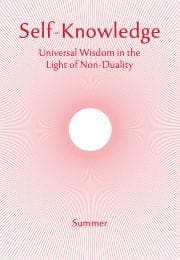The Rose and the Water
The mystical tradition is that the Supreme Consciousness, which is transcendent, beyond time and space and causation, could never be known or express itself unless it had apparently created the world of manifestation, of names and forms. Just as a face can never see itself unless it has a mirror to look into, so the supreme Consciousness has created the universe as a mirror in which to see its own reflection. In the Islamic faith this is expressed by the tradition: ‘I was a hidden treasure, and in order to be known I created the world’.
So the knowability of the Creator depends on the universe which He creates. In the non-dual teachings it is held that the creation is not absolutely real; only Consciousness is Real. Or perhaps it may be said that the manifest universe is an apparent form into which the Consciousness has conjured itself.
An acquaintance of one of the pupils of Wang Yang Ming, a Chinese thinker of the 15th century CE, complained to his friend: ‘Why is the old Master always talking about Consciousness? Take Consciousness out of the discussion, and what else can he talk about?’ to which the reply was: ‘Take away Consciousness, and what is there to talk about?’
It is the position of Advaita. Consciousness is absolutely fundamental. The real and only real element in everything in the universe, is Consciousness. The Sufi poet Jami has expressed the same thing poetically: ‘The rose has gone from the garden; what shall we do with the thorns? The rose is what makes the garden worthwhile.’ He means that if the supreme Consciousness is not recognised as the substratum, of what use is anything in the world?
Abdul Qadir, another great Sufi, arrived at the gate of Baghdad. The other lesser teachers in the city, perhaps fearful of losing disciples, sent him a bowl full to the brim with water; the message intended was ‘Baghdad is already full of teachers; no more can be accommodated here.’ Abdul Qadir produced a beautiful rose and placed it on top of the water and sent it back. He was welcomed into the city with reverence and thereafter was known by the title of ‘The Rose of Baghdad’. That rose, which ‘moved upon the face of the waters’ in the bowl, symbolised the Consciousness which can never be excluded from any part of the universe, yet which transcends manifestation as if floating on it, and which is reflected in it especially as Beauty.
So Jami underlines the primacy of Consciousness: ‘The rose has gone from the garden; what shall we do with the thorns? The Shah is not in the city; what shall we do with his court? When the bird has flown, what shall we do with the cage?’
If we talk of anything other than Consciousness, we are talking of appearances and phenomena. Hari Prasad Shastri has written:
At the back of all the forces of nature and the mental forces of thought, ideation, emotion, etc., is the one great universal force of which all others are modifications. Even our life and the force of cohesion in nature are expressions of that great force. Matter is merely a condensed form of it. We can say it is the cause of all that we know or we can ever know, and it is also the knower.
The identification of Consciousness as the knower is important, both theoretically and practically. Consciousness is not an abstract concept; it is the real marrow of our being. By ‘the knower’ is meant that element in me, the ‘I’ which knows, which is the subject of experience. Of course, everyone is aware of it through introspection, but being aware of it is not necessarily to see it clearly as it really is.
Subscribe or enrol for free guest access to read all of this article and Self-Knowledge online.
Already subscribed or enrolled? Log in:


